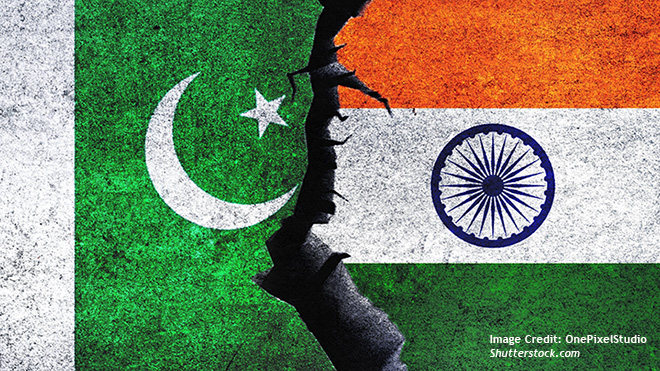
Continuando o exercício de olhar para a Índia, acho importante agora recapitular resumidamente a sua politica para com a vizinhança imediata e as diretrizes que nortearam – e norteiam – as suas relações com o Paquistão.
Se olharmos para o mapa do país veremos que o subcontinente indiano é um território fechado sobre si mesmo: ao norte, a cordilheira dos Himalaias constitui uma barreira natural, e ao sul, o Mar da Arábia, o Oceano Índico e a Baía de Bengala atuam como fronteiras marítimas. Isto tem importância maior que a meramente cartográfica, porque define o caráter único da civilização indiana.
Ainda que isolada pela geografia, a Índia sofreu a influência dos povos que adentraram o seu território ao longo dos milênios e vieram somar-se à população dravídica ancestral. A quase totalidade dessas invasões ocorreu através das planícies férteis do Punjab, na região noroeste que une o seu território ao Paquistão. Entre os primeiros destes povos estavam os arianos indo-europeus, que migraram da Ásia Central e conquistaram a enfraquecida “Civilização do Vale do Indo” (3300 a 1300 AEC). Eles trouxeram consigo os textos sagrados que iriam formatar esta civilização e são o embrião do hinduísmo. De todos, o mais importante, o “Rig Veda”, também chamado de “Livro dos Hinos”, é o documento mais antigo da literatura hindu. Nele está a semente do que seria a definição das “varnas” e castas, que até hoje norteiam as relações interpessoais.
O Islã chegou ao subcontinente no século VII logo após a morte do Profeta Maomé, ainda no início da sua expansão, quando os árabes conquistaram a região do Sindh, no centro-oeste do subcontinente; posteriormente, expandiram-se para o Punjab e o norte da Índia, no século XIII, chegando a Delhi, onde fundaram o Sultanato de Delhi. Desde então, o Islã tornou-se parte da herança religiosa e cultural do império. Sob o sultanato deu-se a síntese da civilização indiana com a islâmica e a integração do subcontinente a um sistema de redes internacionais mais amplas, levado pelos mercadores que cruzavam grande parte da afro-eurásia através das Rotas da Seda. Tal interação teve um impacto muito significativo na cultura e sociedade indianas. Os que visitam Delhi e o norte da Índia notam a herança marcante deixada pelas cultura e estética islâmicas na região.
O apogeu desta civilização ocorreu com a chegada dos Moguls (ou mogóis, segundo alguns autores), quando Babur, descendente direto de Tamerlão, e de Gengis Khan, pelo lado materno, após perder seu trono em Samarcanda, no Uzbequistão, voltou sua atenção para o subcontinente e derrotou Ibrahim Lodi, o último sultão de Delhi, em 1526. O resultante império mogul não interferiu nas sociedades que passou a governar; ao contrário, as equilibrou e pacificou por meio de práticas administrativas inovadoras e inclusivas, dando origem a um governo sistematizado, centralizado e uniforme. Evitando impor a identidade islâmica, os moguls uniram os reinos e feudos locais por meio da lealdade de uma cultura “persianizada” ao imperador. Foi um dos momentos áureos em toda a história da Índia. Algumas destas características permanecem marcantes até hoje em dia, sobretudo no norte do país…
Com o passar do tempo, a dinastia foi-se estiolando. Entrementes, em 31 de dezembro de 1600, a Rainha Elizabeth I, da Inglaterra, autorizou um grupo de comerciantes londrinos a negociar com as chamadas “Índias Orientais”, concedendo-lhes o monopólio do comércio “com todos os países situados a leste do Cabo da Boa Esperança e a oeste do Estreito de Magalhães”. Estava fundada a “Companhia das Índias Orientais”… Em conivência com as elites indianas, sobretudo a realeza, a “East India Company” foi paulatinamente ganhando crescentes espaços. Na segunda metade do século XIX, a administração direta pela coroa britânica e a mudança tecnológica inaugurada pela revolução industrial tiveram o efeito de entrelaçar estreitamente as economias da Índia e da Grã-Bretanha.
Entretanto, as classes intelectuais indianas passaram a resistir com animosidade à exploração da população e das riquezas do país, até que uma revolta, em 1857, nos quartéis de Calcutá envolvendo os chamados “sepaios” – soldados indianos da companhia – ganhou dimensões ameaçadoras, levando a Coroa a dissolver a companhia e assumir o governo: estava formado o “Raj Britânico” e a Rainha Vitória recebeu, em 1877, o título de “Imperatriz das Índias”. O “India Office”, departamento estabelecido em Londres para supervisionar a administração da colônia através de um vice-rei e outros funcionários tornou-se a área mais importante da administração do Império, e a Índia -“the Jewel in the Crown” – a sua joia,
Para resistir aos colonizadores, foi fundado, em 1885, o “Indian National Congress”, partido nacionalista e independentista, que, aliás, dominou por mais de um século a vida política do país. Num crescendo do antagonismo ao “Raj”, foi lançado em agosto de 1942, por inspiração do Mahatma Gandhi, que assumira a liderança da resistência popular, o movimento “Quit India”, exigindo que os britânicos deixassem o país e transferissem o poder político para um governo representativo autóctone. A luta pela independência sobrepôs-se num primeiro momento, graças ao esforço de Gandhi, à divisão político-religiosa entre hindus e muçulmanos. Esta trégua, entretanto, teve pouca duração e coube a Jawarhalal Nehru liderar as falanges hindu e não-islâmica, e a Muhammad Ali Jinnah tornar-se o porta-voz e mentor dos muçulmanos no seio do conflituado “Indian National Congress”: estava configurada a divisão político-religiosa que até hoje acarreta consequências tão funestas para os dois vizinhos. A confrontação culminou no “Ato de Independência da Índia”, de 1947, que acabou com a suserania da Coroa e dividiu o Raj britânico em dois países independentes, o “Domínio da Índia” e o “Domínio do Paquistão”.
Este processo foi um dos mais traumáticos da História devido à forma apressada e atabalhoada com que foi feita a demarcação dos territórios dos países nascentes. A participação do advogado londrino, Sir Cyril Radcliffe, que jamais estivera na Índia, designado pelo Raj para estabelecer as linhas das fronteiras comuns, feita de forma insensível e desconectada das múltiplas realidades no terreno (ele definiu a demarcação dos territórios levando em conta a maioria da população “in loco” – hindu ou muçulmana – sem levar em conta que em todos eles havia minorias do outro credo), foi o estopim de uma das maiores tragédias do século XX, quando milhões de hindus e muçulmanos se deslocaram de seus lares ancestrais para uma nova pátria, e muitos pereceram na chamada “Partição”: jamais se conhecerá o número real de vítimas desta tragédia.
Tudo o que estamos testemunhando na atualidade, sobretudo a radicalização do islamismo em todo o planeta, teve como um dos primeiros berços a confrontação entre muçulmanos separatistas e as autoridades de Delhi na região da Cachemira, cujas fronteiras ainda permanecem insolúveis. Disto tratarei numa próxima postagem.
Doutor em Direito Internacional Público em Paris. Ingressou na carreira diplomática em 1976, serviu nas embaixadas de Bruxelas, Buenos Aires, Nova Déli, Washington, Pequim, Tóquio, Islamabade (onde foi Embaixador do Brasil, em 2004). Também cumpriu missões transitórias no Vietnã e Taiwan. Viveu 15 anos na Ásia, para onde orientou sua carreira por considerar que o continente seria o mais importante do século 21 – previsão que, agora, vê cada vez mais perto da realidade.
